Lakewood Cemetery
Lakewood Cemetery is a large private, non-sectarian cemetery located in Minneapolis, Minnesota, United States. It is located at 3600 Hennepin Avenue at the southern end of the Uptown area. It is noted for its chapel which is on the National Register of Historic Places and was modeled after the Hagia Sophia in Istanbul, Turkey.[2]
Lakewood Cemetery Memorial Chapel | |
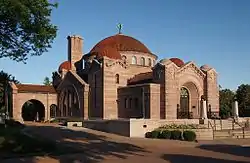 The Byzantine-styled chapel at Lakewood Cemetery is listed on the National Register of Historic Places | |
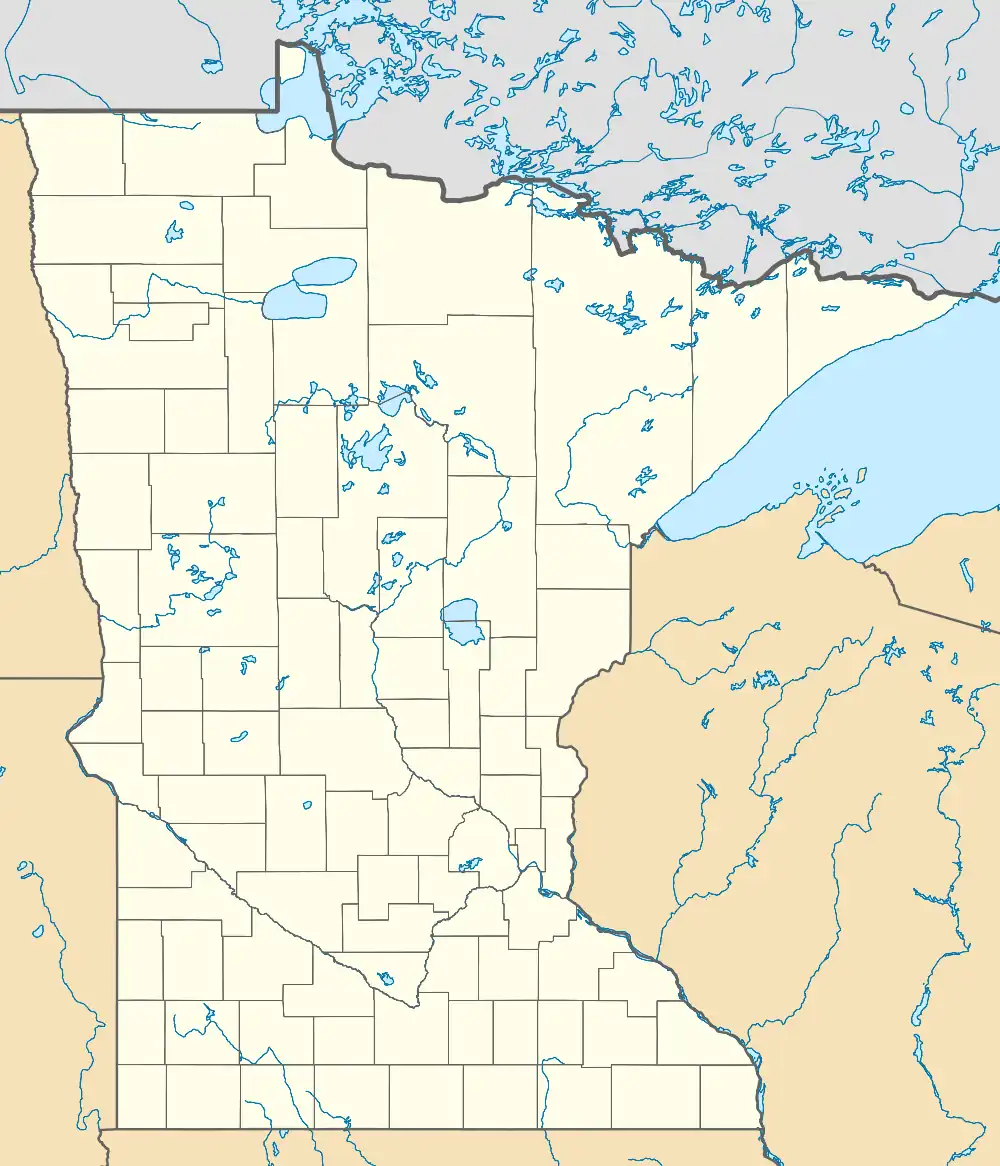 Location in Minnesota  Location in United States | |
| Location | 3600 Hennepin Avenue Minneapolis, Minnesota |
|---|---|
| Coordinates | 44°56′11″N 93°17′56″W |
| Area | 250 acres |
| Built | 1908 |
| Architect | Harry Wild Jones |
| Architectural style | Byzantine Revival |
| Website | www |
| NRHP reference No. | 83003657[1] |
| Added to NRHP | October 20, 1983 |
History
About 250 acres in size, Lakewood memorializes the dead with more than 200,000 monuments, markers and memorializations.[3]: 56 Long considered one of the most beautiful cemeteries in the country, it was modeled after the rural cemeteries of 19th-century France, such as Père-Lachaise in Paris. When Lakewood was established in 1871 rural cemeteries were becoming more popular as part of a growing trend away from churchyard burials in the heart of the city.

In July 1871 Colonel William S. King, local businessman and newspaper publisher, proposed to community leaders of the city that they work together to establish a cemetery "on some of the beautiful locations out near the lakes, where the encroachments of the city would never seriously interfere." In August of the same year a meeting was held for establishing the Lyndale Cemetery Association (Changed to Lakewood in Feb of 1872).[4]: 951 According to the minutes of the original meeting recorded by Thomas Lowry, "that after an examination of various localities they had chosen the land owned by William S. King lying between Lakes Calhoun and Harriet." Colonel King agreed to sell his land for the purpose at a cost of $21,000, "to be paid back over a year at 7 percent interest."[5] The first trustees voted to raise $25,000 to purchase the land and make improvements at a time when the cost of a home in Minneapolis was about $500. The money was raised by selling 250 shares of stock at $100 a piece, two-thirds of which was purchased by the trustees themselves. The remaining balance was solicited by a committee and sold to other local investors. In April 1872 Superintendent A.B. Barton and the board of trustees employed C. W. Folsom, Superintendent of Mount Auburn Cemetery in Cambridge, Massachusetts to develop plans for the new cemetery.[3]: 25 In October 1872 the Association reacquired all stocks that had been sold to the public.[5]
The public dedication of Lakewood was held on September 16, 1872, with "a large number of lots being selected at the close of the exercise by the citizens present."[4]: 952 Many of the earliest lots sold in the 1870s-1880s remained unused until 1972 when they were reclaimed for resale to the public.[3]: 131 The first person buried in Lakewood Cemetery was Maggie Menzel who died on January 24, 1872, at the age of nineteen.[4]: 649–650 [6]
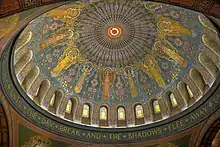
Architect Harry Wild Jones designed the cemetery's chapel which began construction in August 1908. Built of the finest materials, the chapel seats about 200 and is renowned for its beauty and superb acoustics. The dome is 65 feet high with 24 stained glass windows inset its full circumference. Charles R. Lamb of New York orchestrated the design of the chapel's interior mosaic artwork. Six highly skilled artists of Italy were enlisted to create 10 million tessellae in Venice, which were then shipped to Lakewood, where those same artists performed the arduous task of assembling them in the chapel's interior. Completed in 1910, the chapel's total cost of construction was $150,000. Lakewood Chapel was added to the National Register of Historic Places on October 20, 1983.[3]: 103–110
Cremation services were begun in 1910 and have continued to the present day.[7][3]: 17 In 1965-67 a community mausoleum and columbarium was built with enough space for over 5000 crypts and niches. One of the building's more notable features are the 24 eight-foot stained glass windows by Willet Stained Glass Studios of Philadelphia. A large reflecting pool just outside the mausoleum's east side extends toward the garden crypt area and Lakewood's historic chapel nearby.[3]: 112 [8]
In 2012, a new Garden Mausoleum, designed by HGA Architects of Minneapolis, was opened alongside the reflecting pool, adding a further 879 crypts and 4,620 cremation niches.[9][10]
Since its inception in 1872 Lakewood has continued to operate as a non-profit, non-denominational cemetery providing funeral services to the public.[11][4]: 951 Many Minneapolis streets, parks, and monuments bear the names of the Lakewood's original founders — Thomas Lowry, William D. Washburn, and Charles M. Loring, to name a few. The cemetery itself memorializes many notable persons, including former Vice President Hubert H. Humphrey, Civil War General Lewis A. Grant, and Senator Paul Wellstone who was killed in a plane crash in 2002.
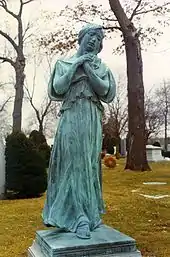
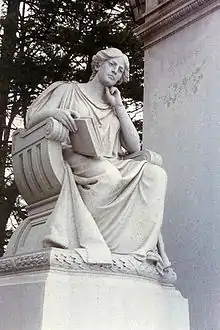
Notable burials
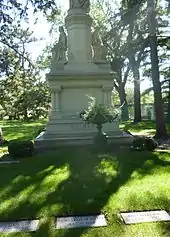
- Albert Abdallah (1878-1968), founder of Abdallah Candies
- Cedric Adams (1902-1961), Journalist and radio personality of Minnesota
- Buzz Arlett (1899-1964), American baseball player, sometimes known as the "Babe Ruth of the minor leagues."
- William F. Beck (August 28, 1904 – October 24, 1966), Bible translator
- Robert Sirelle Brown, first black doctor[12]
- Curt Carlson (1914-1999), founder of Radisson Hotels
- John Crosby (1828-1887), founder of the Washburn-Crosby Company, the forerunner to General Mills
- H. David Dalquist (1918-2005), inventor of the Bundt pan, and founder of Nordic Ware
- Ron Daws (1937-1992), one of three USA 1968 Mexico Olympic Marathon racers; finished 22nd
- George Dayton (1857-1938), founder of Dayton Dry Goods, which became Target Corporation
- William Hood Dunwoody (1841-1914), businessman, and Kate L. Dunwoody, founders of Dunwoody College of Technology
- Mary Jackson Ellis, first African American schoolteacher in Minnesota.[12]
- Steve Foley (1959-2008), drummer for The Replacements
- William Watts Folwell (1833-1929), first president of the University of Minnesota
- Orville Freeman (1918-2003), 29th Governor of Minnesota, Former US Secretary of Agriculture
- Abram M. Fridley (1817-1892), politician and capitalist, after whom Fridley, Minnesota was named
- Frances A. Genter (1898-1992), Thoroughbred racehorse owner who won America's two most important races, the 1990 Kentucky Derby and Breeders' Cup Classic
- Lewis A. Grant (1828-1918), American Civil War general and Assistant U.S. Secretary of War
- Barton S. Hays (1826-1914), artist
- Hubert H. Humphrey (1911-1978), Vice President of the United States, U.S. Senator
- Muriel Humphrey (1912-1998), Second Lady of the United States, U.S. Senator
- Isaac Wilson Joyce (1836-1905), Methodist bishop
- Herbert Butros Khaury (1932 – 1996), also known as Tiny Tim, entertainer and musical archivist
- William S. King (1828-1900), Republican U.S. Representative for Minnesota and journalist
- Robert Koehler (1850-1917), German-born painter and art teacher
- B. Robert Lewis (1931-1979),[13] first African American Minnesota state senator[12]
- Charles M. Loring (1833-1922), Businessman, co-founder of Lakewood Cemetery
- John Hugh MacMillan (1928-2008), businessman[14]
- Bobby Marshall (1880-1958), first African American to play football in Western Conference (later known as the Big 10),[12] one of the first African American NFL players[12]
- Forrest Mars Sr. (1904-1999), creator of M&M's candy
- Frank Clarence Mars (1882-1934), Mars, Incorporated founder
- Maggie Menzel (1853?-1872), First person buried at Lakewood Cemetery
- Maren Michelet (1869-1932), first teacher of Norwegian in any public high school in the United States and promoter of Scandinavian culture.[15]
- George Mikan (1924-2005), professional basketball player[16][17]
- Karl Mueller (1963-2005), Soul Asylum bassist
- Della Whitney Norton (1840-1937), poet, author and Christian Scientist
- Wallace George Nye (1859-1926), 25th Mayor of Minneapolis
- Emil Oberhoffer (1867-1933), founder of the Minneapolis Symphony Orchestra
- William Olander (1950-1989), senior curator at New Museum of Contemporary Art, New York City.
- Floyd B. Olson (1891-1936), 22nd Governor of Minnesota
- Bryan Ottoson (1978-2005), American Head Charge guitarist
- Rudy Perpich (1928-1995), 34th and 36th Governor of Minnesota
- Dave Peterson, coach of the United States men's national ice hockey team[18]
- John S. Pillsbury (1827-1901), eighth Governor of Minnesota, founder of the Pillsbury Company
- Carl Pohlad (1915-2009), owner of the Minnesota Twins
- James Sample (1910-1995), conductor of many orchestras including the Oregon Symphony
- Sibyl Sanderson (1864-1903). famous American operatic soprano during the Parisian Belle Époque.
- George M. Scott (1922-2006), MN Supreme Court Justice, Hennepin County Attorney, candidate for MN Governor
- Clifford D. Simak (1904-1988), American science fiction writer
- Lena Olive Smith, first black female lawyer[12]
- John Pillsbury Snyder (1888-1959), RMS Titanic survivor,[19] and grandson of John S. Pillsbury
- Nellie Snyder (1889-1983), RMS Titanic survivor[20] and wife of John Pillsbury Snyder
- Harriet G. Walker (1841-1917), president of Northwestern Hospital, now part of Allina Hospitals & Clinics
- T. B. Walker (1840-1928), lumberman and art collector, founder of Walker Art Center
- Paul Wellstone (1944-2002), US senator for Minnesota
- Lyle Wright, (1898–1963) businessman, events promoter, United States Hockey Hall of Fame inductee
Photo gallery of notables
 Maggie Menzel's gravestone
Maggie Menzel's gravestone.jpg.webp) Senator Paul Wellstone's grave marker
Senator Paul Wellstone's grave marker.jpg.webp) Carl Pohlad's monument
Carl Pohlad's monument.jpg.webp) Monument of Hubert H. Humphrey
Monument of Hubert H. Humphrey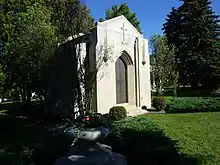 Mars family private mausoleum
Mars family private mausoleum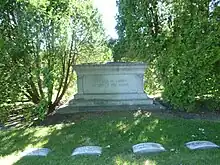 Charles M. Loring, a.k.a. "Father of the Parks"
Charles M. Loring, a.k.a. "Father of the Parks" Fridley family monument
Fridley family monument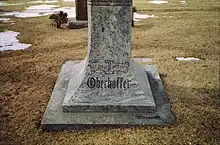 Emil Oberhoffer's obelisk
Emil Oberhoffer's obelisk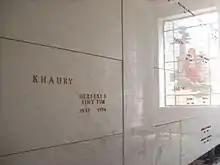 Entertainer Tiny Tim's mausoleum crypt
Entertainer Tiny Tim's mausoleum crypt
Other images
.jpg.webp) Garden of Remembrance
Garden of Remembrance Lakewood Cemetery in Winter
Lakewood Cemetery in Winter%252C_June_2016.jpg.webp) Cemetery Lake (Jo Pond), June 2016
Cemetery Lake (Jo Pond), June 2016.jpg.webp) Lakewood Cemetery Cross
Lakewood Cemetery Cross.jpg.webp)
 Lakewood Mausoleums
Lakewood Mausoleums Memorial to the 1878 Washburn A mill disaster
Memorial to the 1878 Washburn A mill disaster
Notes
- "National Register Information System – (#83003657)". National Register of Historic Places. National Park Service. March 13, 2009.
- "The Lakewood Memorial Chapel". Lakewood Cemetery. Retrieved September 7, 2010.
- Haven in the Heart of the City, The History of Lakewood Cemetery. Lakewood Cemetery. 1992. ISBN 0-9635227-0-1.
- Atwater, Isaac (1893). "History of the City of Minneapolis, Minnesota, Vol II". Google books. Munsell and Company. Retrieved 30 October 2016.
- Lakewood Cemetery. "Lakewood's History". Retrieved 29 October 2016.
- The Minneapolis Journal (June 19, 1906). "Gregor Menzel, Pioneer, is Dead (2nd par.)" (PDF). Library of Congress. Retrieved 30 October 2016.
- "Lakewood Cemetery's crematory". Lakewood Cemetery. Retrieved 19 November 2016.
- "Lakewood's Memorial Mausoleum". Lakewood Cemetery. Retrieved 20 November 2016.
- "Lakewood Mausoleum, designed by HGA". Architect magazine. Retrieved November 11, 2017.
- "Lakewood Cemetery's Garden Mausoleum: Toward the light". Star Tribune. Retrieved November 11, 2017.
- "Lakewood's History". Lakewood Cemetery. Retrieved 20 November 2016.
- "The Secrets Inside Minneapolis's Most Glamorous Graveyard". 14 May 2018.
- "DR. B. ROBERT LEWIS – St Louis Park Historical Society".
- "John H. "Hugh" MacMillan III". Legacy. Retrieved 23 November 2014.
- Veblen, Andrew A. (1920). The Valdris book; a manual of the Valdris samband. pp. 76–77. Retrieved 28 July 2017.
- Millett, Larry (2009). AIA Guide to the Minneapolis Lake District. Minnesota Historical Society Press. p. 76. ISBN 9780873516457.
- Metzger, Michael (July 25, 2005). "The Dead Zone". Southwest Journal. Retrieved April 14, 2018.
- "David Richard Peterson". Lakewood Cemetery. Retrieved February 20, 2023.
- "Mr. John Pillsbury Snyder". Encyclopedia Titanica.
- "Mrs Nelle Snyder". Encyclopedia Titanica.